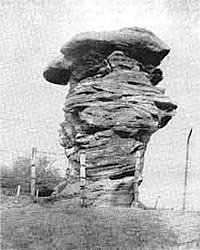The Hemlock Stone
 |
THERE are in the neighbourhood few more puzzling relics of the past than the Hemlock Stone, near Bramcote. Geologists tell us that it is a perfectly natural object, being a mass of red sandstone, whose summit is more or less protected by a harder formation, and that its curious shape is due to the weathering of countless ages.
For a generation this explanation has been accepted, and inquirers as to the meaning of the Hemlock Stone have turned, perhaps regretfully, away from the tradition that equated the word "Hemlock" with "Cromlech," the name for those mysterious Rude Stone Circles of unknown antiquity and use, and which roundly declared that the Hemlock Stone was a "Druid Altar" —whatever that may mean.
Certain discoveries have been made recently in this neighbourhood, however, which seem to indicate that there is something in this tradition after all, for they point, in a very shadowy way it is trite, to a very early occupation of the district by man, and almost any time something may be found which may conceivably throw the district into the archaeological limelight.
It is well, therefore, to keep a very open mind and a very sharp look-out, when considering the neighbourhood in which stands the Hemlock Stone.
